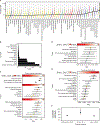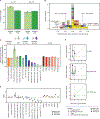The origins and functional effects of postzygotic mutations throughout the human life span
- PMID: 37053313
- PMCID: PMC11246725
- DOI: 10.1126/science.abn7113
The origins and functional effects of postzygotic mutations throughout the human life span
Abstract
Postzygotic mutations (PZMs) begin to accrue in the human genome immediately after fertilization, but how and when PZMs affect development and lifetime health remain unclear. To study the origins and functional consequences of PZMs, we generated a multitissue atlas of PZMs spanning 54 tissue and cell types from 948 donors. Nearly half the variation in mutation burden among tissue samples can be explained by measured technical and biological effects, and 9% can be attributed to donor-specific effects. Through phylogenetic reconstruction of PZMs, we found that their type and predicted functional impact vary during prenatal development, across tissues, and through the germ cell life cycle. Thus, methods for interpreting effects across the body and the life span are needed to fully understand the consequences of genetic variants.
Conflict of interest statement
Competing interests
D.F.C. is an advisor to Paterna Biosciences. All other authors declare that they have no competing interests.
Figures




References
-
- Genovese G, Kähler AK, Handsaker RE, Lindberg J, Rose SA, Bakhoum SF, Chambert K, Mick E, Neale BM, Fromer M, Purcell SM, Svantesson O, Landén M, Höglund M, Lehmann S, Gabriel SB, Moran JL, Lander ES, Sullivan PF, Sklar P, Grönberg H, Hultman CM, McCarroll SA, Clonal hematopoiesis and blood-cancer risk inferred from blood DNA sequence. N. Engl. J. Med. 371, 2477–2487 (2014). - PMC - PubMed
-
- Xie M, Lu C, Wang J, McLellan MD, Johnson KJ, Wendl MC, McMichael JF, Schmidt HK, Yellapantula V, Miller CA, Ozenberger BA, Welch JS, Link DC, Walter MJ, Mardis ER, Dipersio JF, Chen F, Wilson RK, Ley TJ, Ding L, Age-related mutations associated with clonal hematopoietic expansion and malignancies. Nat. Med. 20, 1472–1478 (2014). - PMC - PubMed
MeSH terms
Grants and funding
LinkOut - more resources
Full Text Sources

